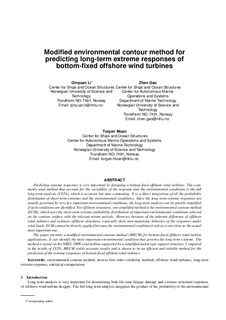| dc.contributor.author | Li, Qinyuan | |
| dc.contributor.author | Gao, Zhen | |
| dc.contributor.author | Moan, Torgeir | |
| dc.date.accessioned | 2017-10-30T09:26:02Z | |
| dc.date.available | 2017-10-30T09:26:02Z | |
| dc.date.created | 2016-11-03T10:21:02Z | |
| dc.date.issued | 2016 | |
| dc.identifier.citation | Marine Structures. 2016, 48 15-32. | nb_NO |
| dc.identifier.issn | 0951-8339 | |
| dc.identifier.uri | http://hdl.handle.net/11250/2462761 | |
| dc.description.abstract | Predicting extreme responses is very important in designing a bottom-fixed offshore wind turbines. The commonly used method that account for the variability of the response and the environmental conditions is the full long-term analysis (FLTA), which is accurate but time consuming. It is a direct integration of all the probability distribution of short-term extremes and the environmental conditions. Since the long-term extreme responses are usually governed by very few important environmental conditions, the long-term analysis can be greatly simplified if such conditions are identified. For offshore structures, one simplified method is the environmental contour method (ECM), which uses the short-term extreme probability distribution of important environmental conditions selected on the contour surface with the relevant return periods. However, because of the inherent difference of offshore wind turbines and ordinary offshore structures, especially their non-monotonic behavior of the responses under wind loads, ECM cannot be directly applied because the environmental condition it selects is not close to the actual most important one.
The paper presents a modified environmental contour method (MECM) for bottom-fixed offshore wind turbine applications. It can identify the most important environmental condition that governs the long-term extreme. The method is tested on the NREL 5 MW wind turbine supported by a simplified jacket-type support structure. Compared to the results of FLTA, MECM yields accurate results and is shown to be an efficient and reliable method for the prediction of the extreme responses of bottom-fixed offshore wind turbines. | nb_NO |
| dc.language.iso | eng | nb_NO |
| dc.publisher | Elsevier | nb_NO |
| dc.rights | Attribution-NonCommercial-NoDerivatives 4.0 Internasjonal | * |
| dc.rights.uri | http://creativecommons.org/licenses/by-nc-nd/4.0/deed.no | * |
| dc.title | Modified Environmental Contour Method for Predicting Long-term Extreme Responses of Bottom-fixed Offshore Wind Turbines | nb_NO |
| dc.type | Journal article | nb_NO |
| dc.type | Peer reviewed | nb_NO |
| dc.description.version | acceptedVersion | nb_NO |
| dc.source.pagenumber | 15-32 | nb_NO |
| dc.source.volume | 48 | nb_NO |
| dc.source.journal | Marine Structures | nb_NO |
| dc.identifier.doi | 10.1016/j.marstruc.2016.03.003 | |
| dc.identifier.cristin | 1396889 | |
| dc.relation.project | Norges forskningsråd: 223254 | nb_NO |
| dc.description.localcode | © 2016. This is the authors’ accepted and refereed manuscript to the article. LOCKED until 12.5.2018 due to copyright restrictions. This manuscript version is made available under the CC-BY-NC-ND 4.0 license http://creativecommons.org/licenses/by-nc-nd/4.0/ | nb_NO |
| cristin.unitcode | 194,64,20,0 | |
| cristin.unitname | Institutt for marin teknikk | |
| cristin.ispublished | true | |
| cristin.fulltext | postprint | |
| cristin.qualitycode | 2 | |

